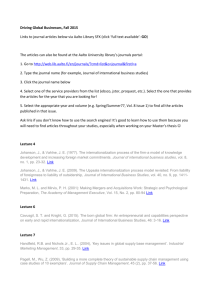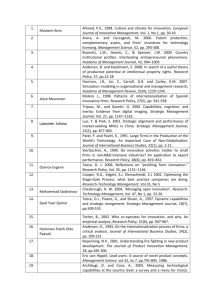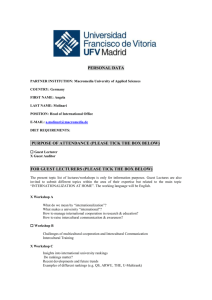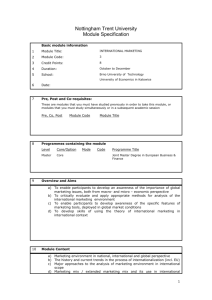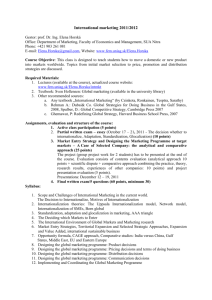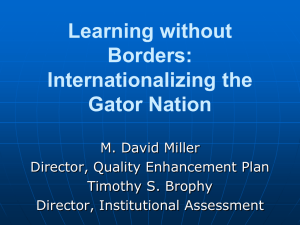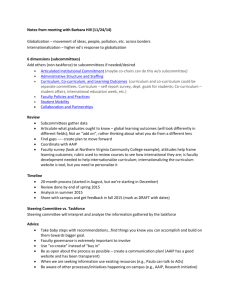Understanding the Scope and Boundaries of Regional Innovation
advertisement
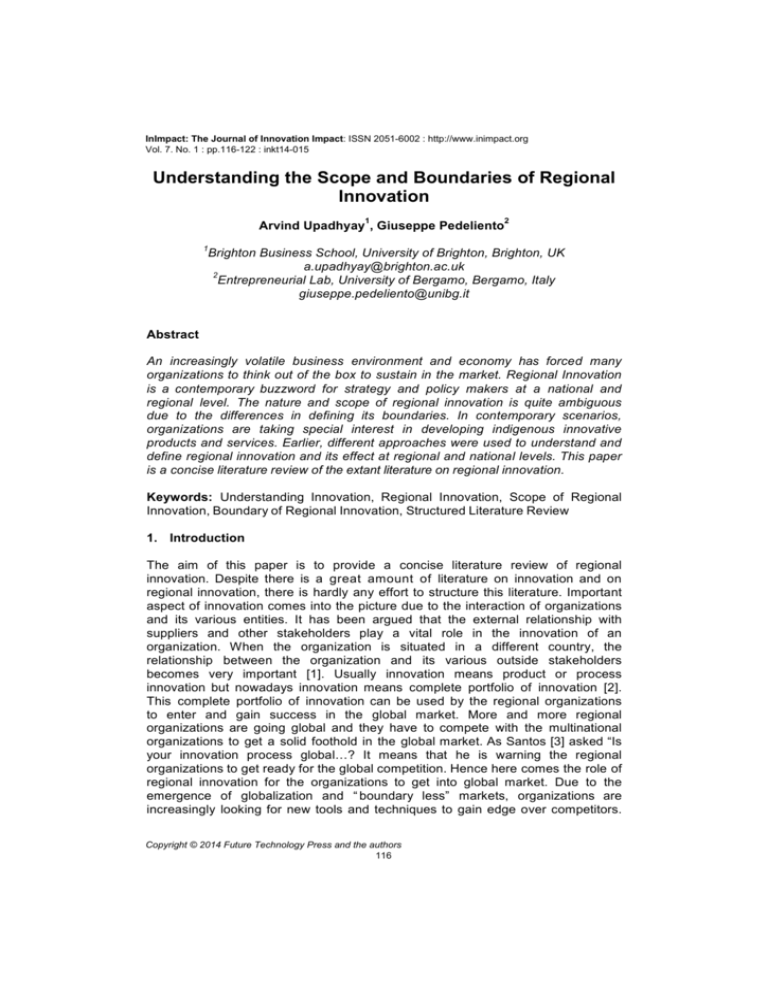
InImpact: The Journal of Innovation Impact: ISSN 2051-6002 : http://www.inimpact.org Vol. 7. No. 1 : pp.116-122 : inkt14-015 Understanding the Scope and Boundaries of Regional Innovation 1 Arvind Upadhyay , Giuseppe Pedeliento 1 2 Brighton Business School, University of Brighton, Brighton, UK a.upadhyay@brighton.ac.uk 2 Entrepreneurial Lab, University of Bergamo, Bergamo, Italy giuseppe.pedeliento@unibg.it Abstract An increasingly volatile business environment and economy has forced many organizations to think out of the box to sustain in the market. Regional Innovation is a contemporary buzzword for strategy and policy makers at a national and regional level. The nature and scope of regional innovation is quite ambiguous due to the differences in defining its boundaries. In contemporary scenarios, organizations are taking special interest in developing indigenous innovative products and services. Earlier, different approaches were used to understand and define regional innovation and its effect at regional and national levels. This paper is a concise literature review of the extant literature on regional innovation. Keywords: Understanding Innovation, Regional Innovation, Scope of Regional Innovation, Boundary of Regional Innovation, Structured Literature Review 1. Introduction The aim of this paper is to provide a concise literature review of regional innovation. Despite there is a great amount of literature on innovation and on regional innovation, there is hardly any effort to structure this literature. Important aspect of innovation comes into the picture due to the interaction of organizations and its various entities. It has been argued that the external relationship with suppliers and other stakeholders play a vital role in the innovation of an organization. When the organization is situated in a different country, the relationship between the organization and its various outside stakeholders becomes very important [1]. Usually innovation means product or process innovation but nowadays innovation means complete portfolio of innovation [2]. This complete portfolio of innovation can be used by the regional organizations to enter and gain success in the global market. More and more regional organizations are going global and they have to compete with the multinational organizations to get a solid foothold in the global market. As Santos [3] asked “Is your innovation process global…? It means that he is warning the regional organizations to get ready for the global competition. Hence here comes the role of regional innovation for the organizations to get into global market. Due to the emergence of globalization and “ boundary less” markets, organizations are increasingly looking for new tools and techniques to gain edge over competitors. Copyright © 2014 Future Technology Press and the authors 116 Understanding the Scope and Boundaries of Regional Innovation Arvind Upadhyay, Giuseppe Pedeliento Developing indigenous products and services by regional innovation is the order of the day. Many researchers worked on importance of regional resources in improving the innovation capability of an organization [4, 5, 6]. While some other researchers linked it to the Industrial output [7, 8]. The main issues in regional innovation are to understand its nature, scope and application. Earlier work mostly dealt with defining the regional innovation and its scope linked with the industrial output. However, this paper focuses on structured literature and using regional innovation as a strategic tool. 2. Literature Review Since the second half of the 20th century the role of innovation as a key driver of the competitive challenge and as the only one competitive advantage which can enable firms to survive in hyper-competitive markets, has become one of the main issue on which scholars try to shed light. The concern about innovation grows jointly with internationalization because both processes seems to characterize strongly the competitiveness (and the strategies) of businesses and countries. But how can we define innovation? And also how to define internationalization? Innovation, according to Rogers [9] is “an idea, practice, or object that is perceived as new by an individual or other unit of adoption”. Schumpeter [10] defined five different type of innovation: • • • • • Introduction of a new product or qualitative change in an existing product; Process innovation new to an industry; The opening of a new market; Development of new sources of supply for raw materials or other inputs; Changes in industrial organization. 2.1. Internationalization Internationalization could be defined as a “process of increasing involvement of enterprises in international markets” [11] or as “the process of increasing involvement in international operations” [12] or, again, as “the process of adapting a company’s operations (strategy, structure, resources, etc.) to international environments” [13]. In this literature review we try to go back over some of the most important contributions about a company’s internationalization process, innovation and national/regional innovation system in order to show that each of this corpus of literature could be considered jointly with each other. It is possible to assert this because it is well known that innovation is a driver of the internationalization processes as well as internationalization is a way by which companies can access to sources of innovation they do not have in their own country. Moreover both innovation and internationalization are processes characterized in being very country/region specific. The early literature about company’s internationalization was developed among economists in order to explain the dynamics of foreign direct investment (FDI) and 117 Understanding the Scope and Boundaries of Regional Innovation Arvind Upadhyay, Giuseppe Pedeliento was focused on multinational activity. Nonetheless innovation - since the beginning of the business internationalization study - had a strong influence in explaining the growth of international relationships among companies. However we can consider these contributions also useful in explaining why, how and where firms in general internationalize their activities. The early work by Hymer [14] represents a first attempt in defining the reasons that encourage companies to invest abroad. He identified the existence of competitive advantages and the wish to exploit them outside national boundaries as the main reason why companies internationalize their operations and consider innovation as a potential source of these competitive advantages. Dunning [15] in his well-known “eclectic paradigm” stated that companies establish branches in foreign countries if they have strong firm specific advantages and if in such countries they can exploit localization advantages. In Dunning [15] the control of a certain technology has to be considered as ownership specific advantages which enable firms to extend their activity abroad. Vernon [16] considers innovation the most important dynamic factor behind the internationalization process of economic systems. 2.2. Regional Innovation Other authors [17, 18] state that firm specific advantages are directly linked with the pace of their investments in research and development (R&D) and with product differentiation; both bring companies to spread direct investments abroad. More recently Caves [19] observed that there’s a strong relationship between R&D investments and the presence of multi-national enterprises in several sector. Other authors, such as Archibugi and Michie [20] try to shed light on the existing link between innovation and internationalization processes and have introduced the notion of “globalization of technology” in order to explain the international exploitation of nationally-produced technology, the global generation of innovations and the global technological collaborations. One of the major contributions for the explanation of company’s internationalization processes is the so called Uppsala Internationalization Process Model [21, 22]: it describes – from a learning/evolutionary point of view - internationalization as a process of experiential learning and incremental commitment which leads to an evolutionary development in a foreign market. One of the basic assumptions of the model is that “the lack of knowledge is an important obstacle to the development of international operations” [22]. In this model it has been observed that the absence of market-specific knowledge forces companies to develop their international operations step by step, undertaking incremental commitment decisions and moving at the beginning to psychically closer countries in order to reduce the market uncertainty. The Uppsala Model has stimulated the emergence of the “network theory” [23], which states that relationships also have a key role in the internationalization process enabling companies (especially the small ones) to access to technological, productive and market resources they lack. 118 Understanding the Scope and Boundaries of Regional Innovation Arvind Upadhyay, Giuseppe Pedeliento 2.3. Innovation in Internationalization So, it is clear that innovation is one of the key factors in the explanation of the internationalization process. The more the competition among companies becomes global, the more the connection between innovation and national/regional institutions assumes importance. It is not a case that the term “glocal” - coined within Japanese business practices and adopted in the Anglo-Saxon slang thanks to the stimulus of the sociologist Zygmunt Bauman [24] - has become a leit motive for the most part of those firms which “go global”. This challenge has to be considered not a limitation which firms have to face, but as an opportunity which can allow firms to increase their competitiveness. Moreover, since the ‘80’s scholars were attracted by the study of the so called “national innovation systems” [25] An exhaustive definition of this was given by Metcalfe [26] “a national system of innovation may be defined as that set of distinct institutions which jointly and individually contribute to the development and diffusion of new technologies, and which provides the framework within which governments form and implement policies to influence the innovation process. As such, it is a system of interconnected institutions to create, store and transfer the knowledge, skills and artifacts which define new technologies. The element of nationality follows not only from the domain of technology policy but also from elements of shared language and culture which bind the system together, and from the national focus of other policies, laws and regulations which condition the innovative environment”. In recent years the concept of national innovation systems has evolved and the regional dimension has received more attention. The rise in the popularity of the concept of regional innovation systems is due on one hand to the emergence of successful clusters and district of firms and industries in several regions around the world [27] ,on the other because the phenomenon of globalization puts pressure on small and medium enterprises to develop strategies for internationalization [28]. 3. Scope and Boundaries of Regional Innovation Researchers have different views on defining and classifying the area of regional innovation. Here an area means the physical region which can be considered as part of regional innovation. We argue that there is no hard and fast rule to define the length and breadth of such regional innovation areas because the natural capabilities of an area may change due to the passage of time like existence of natural resources, changes in the type of soil etc. Hence, the area can loose and gain innovative capability over a period of time. To implement corporate strategy, organizations usually have different methods and policies. Strategic tools are mainly used to implement the corporate strategy of the organization and are aligned with the vision and mission of the company. Organizations define the strategic goals for the different strategic business units. These strategic business units’ works at regional level and make the strategic plan for their specific niche market. We argue that these business units can use the regional innovation as a tool to get the edge over the competitors. 119 Understanding the Scope and Boundaries of Regional Innovation Arvind Upadhyay, Giuseppe Pedeliento 4. Contribution and Practical Implication Current understanding of regional innovation is very limited. Doloreux [27] did some study and tried to develop a theoretical approach to understand the critical nature of regional innovation. This paper is in line with the same study and explores more about the complex nature of regional innovation. And can be considered as a new rain drop in a sea of regional innovation and global competitiveness. It also motivates other researchers to work in the same direction and explore the complexities of regional innovation. The findings can be very useful for the regional organizations which are planning to go global by using regional innovation as a strategic tool to get the competitive edge. It is more specifically useful for small and medium enterprises (SME), e.g. In the auto component manufacturing sector. The research findings are specific to the organizations which are targeting regional innovation as a strategic tool to get an edge o v e r t h e c o m p e t i t o r s . Hence this can be a very good benchmarking guidebook for the organizations who wants to understand the concept of regional innovation and also implement it. This research paper can act as a refresher guide for them and can pave the path for success in global competitive market. 5. References [1] Roy, S. and Sivakumar, K. Innovation generation in supply chain relationships: a conceptual model and research propositions. Project Management Journal. Vol. 12:2, pp. 43-49 (2004) [2] Davenport, J. UK film companies: project-based organizations lacking entrepreneurship and innovativeness. Creativity and Innovation Management. Vol. 15:3, pp. 250-257 (2006) [3] Santos, J., Doz, Y. and Williamson, P. Is your innovation process global. MIT Sloan Management Review. Vol. 45:4, pp. 31-37 (2004) [4] Asheim, B., Isaksen, A., Nauwelaers, C. and Tötdling, F. Regional innovation policy for small & medium enterprises. Cheltenham, UK and Lyme, US, Edward Elgar (2003) [5] Cooke, P. Regional innovation systems, clusters, and the knowledge economy. Industrial and Corporate Change. Vol. 10, pp. 945-974 (2001) [6] Wolfe D. Knowledge, learning and social capital in Ontario's ICT clusters. Paper prepared for the Annual Meeting of the Canadian Political Science Association. University of Toronto, Toronto, Ontario May 29-31 (2002) [7] Maillat D. From the industrial district to the innovative milieu: contribution to an analysis territorialized production organizations. Universite´ de Neutchatel. Discussion Paper (1998) 120 Understanding the Scope and Boundaries of Regional Innovation Arvind Upadhyay, Giuseppe Pedeliento [8] Markusen, A. Sticky places in slippery space: a typology of industrial districts. Economic Geography. Vol. 72, pp. 293–313 (1996) [9] Rogers, E.M. Diffusion of innovations. 5th Edition, New York, Free Press (2003) [10] Schumpeter, J. The theory of economic development. Harvard University Press. Cambridge (1934) [11] Susman, G. Small and medium-sized enterprises and the global economy. Edward Elgar Publishing (2007) [12] Welch L.S. and Loustarinen R. Internationalization: evolution concept. Journal of General Management. Vol.14, pp. 34-55 (1988) of a [13] Calof J.L. and Beamish P.W. Adapting to foreign markets: explaining internationalization. International Business Review, Vol. 4, pp. 115-131 (1995) [14] Hymer, S. H. The international operations of national firms: a study of direct foreign investment. Cambridge, MA MIT Press (1976) [15] Dunning, J.H.: Trade location of economic activity and the MNE: a search for an eclectic approach. In B. Ohlin (Ed.), The international allocation of economic activity, Holmes and Meier, London. England (1977) [16] Vernon R. International investment and international trade in the product cycle. Quarterly Journal of Economics. Vol. 80, pp. 190-207 (1966) [17] Anderson E. and Gatignon H. Modes of foreign entry: a transaction cost analysis and propositions. Journal of International Business Studies. Vol.17, pp. 126 (1986) [18] Stopford J.M. and Wells L.T. Managing the multinational enterprise: Organization of the firm and ownership of the subsidiaries. New York, Basic Books (1972) [19] Caves R. Multinational enterprise and economic analysis. Cambridge, Cambridge University Press (1996) [20] Archibugi, D. and Michie, J. The globalization of technology: a new taxonomy. Cambridge Journal of Economics. Vol.19, pp. 121-140 (1995) [21] Johanson J. and Wiedersheim-Paul F. The internationalization of the firm – four cases. Journal of Management Studies. Vol.12, pp. 305-322 (1975) [22] Johanson, J. and Vahlne, J. E. The internationalization process of the firm – a model of knowledge development and increasing foreign market 121 Understanding the Scope and Boundaries of Regional Innovation Arvind Upadhyay, Giuseppe Pedeliento commitments. Journal of International Business Studies. Vol.8, pp. 23-32 (1977) [23] Johanson J. and Vahlne J. E.: Business relationship learning and commitment in the internationalization process. Journal of International Entrepreneurship. Vol.1, pp. 83-101 (2003) [24] Bauman Z.: Globalization and glocalizzazione. Armando Editore, Rome (2005) [25] Freeman, C.: Technology policy and economic performance: lessons from Japan. London, Pinter (1987) [26] Metcalfe S .: Technology systems and technology policy. Evolutionary Framework: Technology, Globalisation and Economic Performance (1997) [27] Doloreux D., Parto S.: Regional innovation systems: current discourse and unresolved issues. Technology in Society, n. 27, pp. 133–153 (2005) [28] Gemser G., Brand M. J., Sorge A.: Exploring the internationalization process of small businesses: a study of Dutch old and new economy firms. Management International Review. n. 44, pp. 127-150 (2004) 122

